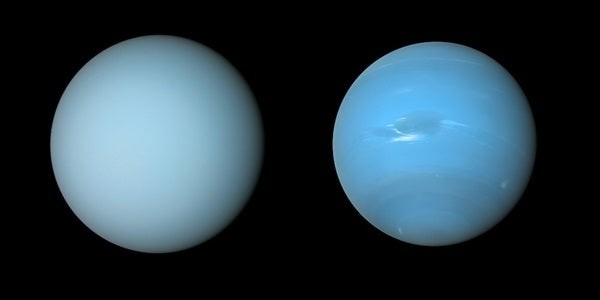Neptune and Uranus, the ice giants of our solar system, often appear similar in casual observation. Both exhibit shades of blue, leading to confusion. This article delves into the size comparison between these two distant planets, exploring their similarities and subtle differences.
Size and Mass: A Close Match
Surprisingly, Neptune and Uranus are remarkably close in size and mass. Uranus boasts a diameter of about 31,518 miles (50,724 kilometers), while Neptune measures slightly smaller at roughly 30,599 miles (49,244 kilometers). This difference of about 900 miles (1,500 kilometers) is minimal in the grand scale of planetary dimensions. To put it in perspective, Uranus is only about 1.03 times wider than Neptune.
In terms of mass, Uranus is approximately 14.5 times the mass of Earth, whereas Neptune is about 17 times Earth’s mass. While Neptune is slightly denser, the overall mass difference is relatively small. This near parity in size and mass contributes to their similar gravitational pulls and overall densities.
Image Credit: Astronomy: Roen Kelly. An artistic rendering showcasing the relative sizes of Uranus and Neptune, along with their ring systems and some of their moons.
Composition and Atmospheric Similarities
Beyond size, Uranus and Neptune share striking similarities in their composition. Both are classified as “ice giants,” primarily composed of elements heavier than hydrogen and helium, such as water, methane, and ammonia. These elements exist in fluidic states under immense pressure, forming the planets’ icy mantles.
Their atmospheres are also predominantly hydrogen and helium, with traces of methane. It’s this methane that absorbs red light and reflects blue light, giving both planets their characteristic bluish hues. However, a slight difference in atmospheric haze contributes to the subtle variations in their colors. Uranus appears slightly paler due to a thicker layer of haze, while Neptune’s more active atmosphere results in a deeper azure.
Subtle Differences in Color
While similar in composition, Uranus and Neptune exhibit subtle color differences. Recent research suggests that the variation arises from the distribution of haze particles in their atmospheres. Uranus possesses a more stagnant atmosphere, allowing haze to accumulate and lighten its overall appearance. Conversely, Neptune’s more dynamic atmosphere efficiently disperses haze, resulting in a richer blue hue.
Image Credit: NASA, ESA, STScI, M.H. Wong (University of California, Berkeley) and L.A. Sromovsky and P.M. Fry (University of Wisconsin-Madison). Hubble image capturing dark spots on Neptune, thought to be storms in the deeper layers of its atmosphere.
Conclusion: Near Twins, Yet Distinct
In conclusion, Neptune and Uranus are nearly identical in size, with Uranus having a slightly larger diameter. Their masses and compositions are also strikingly similar, classifying them both as ice giants. However, subtle differences in atmospheric dynamics and haze distribution lead to variations in their color, making Neptune appear a deeper blue than Uranus. Despite these nuances, both planets remain fascinating subjects of ongoing research, with future missions poised to unlock further secrets of these distant icy worlds.

